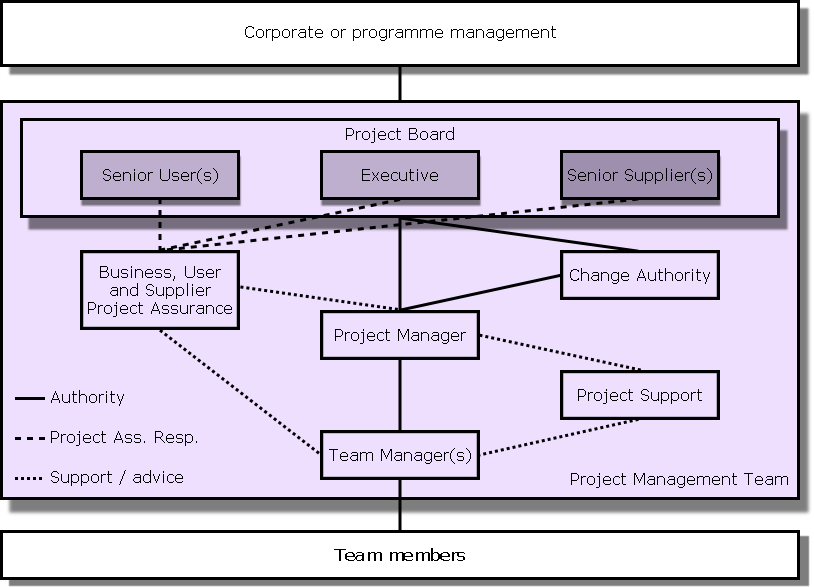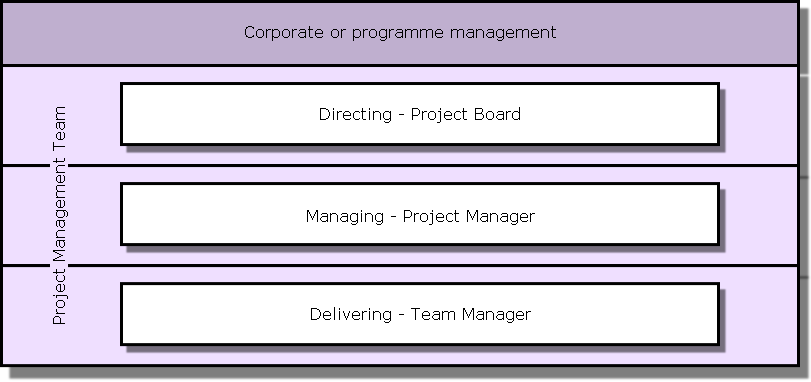Purpose
To define and establish the project’s structure of accountability and responsibilities.
To answer:
“Who is responsible for what?”
“What is expected from me?”
“What is expected from anybody in the project?”
Definitions
A project is a temporary organisation that is created for the purpose of delivering one or more business products according to an agreed business case.
A programme is a temporary flexible organisational structure created to coordinate, direct and oversee the implementation of a set of related projects and activities, in order to deliver outcomes and benefits related to the organisation’s strategic objectives.
The term corporate organisation refers to an organisation’s general management.
PRINCE2 places responsibilities into roles (not persons or jobs). Roles can be assigned to persons. Persons can have more than one role. Some roles may be shared between persons.
A stakeholder is any person or group that can be effected by or have an effect on the project.
In a project there are 3 primary interests to be represented in the Project Board:
- The business interest is concerned that the products of the project meet a business need which will justify the investment in the project. The Executive role is defined to look after the business interests.
- The user interest are the requirements of the users of the projects products. The use of the products themselves and those who are impacted by the projects outputs and also operating, maintaining or supporting of the products are considered user interests. The Senior User role will represent the user interests.
- The creation / realisation of the products will require resources with certain skills to be supplied to the project team. The Senior Supplier role will represent the Supplier interests.
(PRINCE2 is based on Customer / Supplier environment. Here the Business and User interests lie with the customer while the Supplier interests lie with the supplier. A common exception to this model is Product development environment, where the Business and Supplier interests are aligned and the Users interests are external to the organisation. These interests still need to be represented in some way - possibly by the Sales / Marketing departments.)
Approach to Business Case
A successful project management team should have:
- Business, User and Supplier stakeholder representation.
- Defined responsibilities for directing, managing and delivering the project and define accountability at each level.
- Reviewed project roles throughout the project.
- Managed communication strategy to/from key stakeholders.
The Project Management Team structure and lines of reporting:

Project Board
- Accountable for success or failure
- Provide (unified) direction to the project
- Provide resources and authorise funds
- (Visible) support for Project Manager
- Ensure effective communication
Project Assurance
The Project Board is responsible for Project Assurance independent of the Project Manager. They can opt to perform this role themselves or appoint individuals to carry this out. Monitor performance and advises the Project Manager.
On behalf of the Executive:
- Ensure business aspects are correct
- Is the project value for money
On behalf of the Senior User:
- Ensure the delivered products will meet requirements
- Will the end products work as expected?
On behalf of the Senior Supplier:
- Ensure the products can/will be delivered as expected
- Can it be done within time, cost and other variables?
Change Authority
- Control Change Requests and off-specifications.
- Role may be delegated to a number of levels, linked to severity of the change:
| Corp. / Programme management | > € 25000 |
| Project Board | Up to € 25000 |
| Change Authority | Up to € 5000 |
| Project Manager | Up to € 1000 |
| Project Support / helpdesk | € 0 |
Project Support
- Administrative support for Project Manager
- Advice & guidance on tools and Configuration Management
- Project manager is responsible; role is not optional
- Some companies have a Project Office / Support Office
Project Manager
- Manage the project on a day to day basis
- Run the project on behalf of the Project Board
- PRINCE2 prefers the Project Manager comes from the Customer organisation
- Responsible for all processes except “Directing a Project”
- Responsible for Project Support and Team Managers
- As the Project Manager is the single (day to day) focus in the project he needs to address and understand the many different aspects of Project Management. Some of the required skills are:
- Cost management
- Communication
- Change management
- Teamwork & team building
- Strategy
- Line management
- Planning, monitoring & control
Team Manager
- Optional: usually not required in small projects
- Used when project size dictates
- Used when specialised knowledge is needed
- Used when remote teams are involved
- Used when external companies are involved
- Produce the products assigned in Work Packages
- Report to Project Manager
Stakeholder engagement
- Identify and communicate with people and groups
- Identification is done at project start
- External stakeholder can influence the project considerably
- Good communication is essential to the project
Stakeholder may support or oppose the project depending on whether they gain or lose as a result of project delivery. They see the project as either an enhancement or a threat to their position and become active supporters or blockers of the project and its progress.
Communication Management Strategy
- Defines how communication will be done during the project
- Defines the rules of engagement for communication
- Defines means and frequency of communication
- Defines roles and responsibilities for reporting and communication
- Created by Project manager in Initiation Stage, reviewed in the Stage Boundaries
- May be based on corporate / Programme templates

